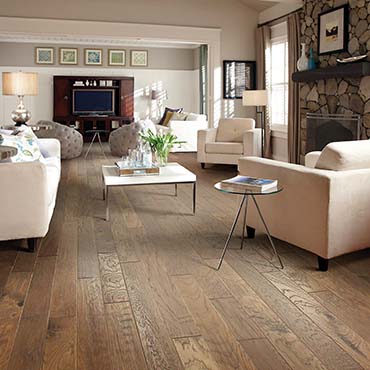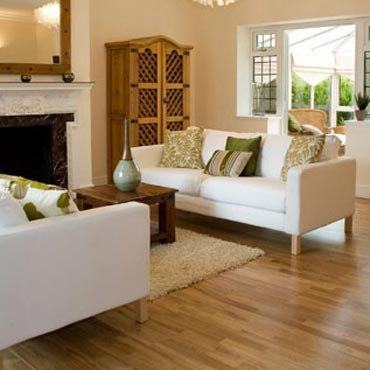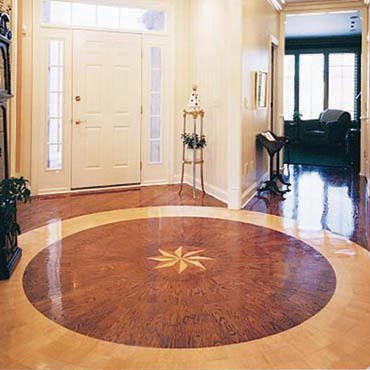Shaw Hardwood Flooring offers consumers the timeless tradition of hardwood flooring with a wide variety of species, colors, and sizes. Shaw hardwood flooring brings Beauty and Strength to Any Room. See our Collection of Wood Flooring Stains and Grains. Learn More
Crests and Medallions
Crests and Medallions Guide

Elevating Spaces with Artistry: The Role of Wood Flooring Crests and Medallions in Contemporary Design
In the realm of modern architecture and interior design, the inclusion of wood flooring crests and medallions stands as a testament to the harmonious blend of tradition and innovation. These elements not only add a touch of elegance and distinctiveness to spaces but also align with the growing emphasis on sustainable and versatile materials. As architects, designers, and building contractors, understanding the intricacies of these decorative features is crucial in creating environments that are both aesthetically pleasing and functionally robust.
Defining the Artistry: Crests and Medallions in Wood Flooring
A crest in wood flooring is a decorative design, often emblematic or symbolic, intricately inlaid or carved into the wood. These crests can range from family coat of arms to corporate logos, offering a personalized touch to the space. Medallions, on the other hand, are ornate, circular or geometric designs that serve as a focal point on the floor. Both crests and medallions can be crafted from various wood types, each bringing its unique texture, color, and pattern to the design.
Exploring Types and Characteristics
The most popular types of wood used in flooring crests and medallions include oak, walnut, maple, and cherry. Each type offers unique characteristics:
- Oak: Known for its durability and distinctive grain patterns, oak is ideal for traditional and rustic designs.
- Walnut: Valued for its rich, dark tones, walnut adds a sense of luxury and is well-suited for elegant, sophisticated spaces.
- Maple: With its lighter hue and subtle grain, maple is perfect for contemporary designs, offering a clean, minimalist look.
- Cherry: Cherished for its warm, reddish tones that deepen over time, cherry wood is ideal for creating a cozy and inviting atmosphere.
Installation and Environmental Suitability
The installation of wood flooring crests and medallions requires precision and expertise. Oak and maple, with their hardness, offer easier handling and resistance to wear, making them suitable for high-traffic areas. Walnut and cherry, while softer, provide a luxurious feel but might require more maintenance, especially in areas with high moisture. The choice of wood should also consider factors like sunlight exposure and humidity levels to ensure longevity and preservation of the design's integrity.
Sustainability: A Core Consideration
Sustainability in material choice is no longer a trend but a necessity. When selecting wood for flooring crests and medallions, it’s important to consider sources that practice responsible forestry. This includes looking for certifications like FSC (Forest Stewardship Council) or PEFC (Programme for the Endorsement of Forest Certification), ensuring that the wood is not only of high quality but also environmentally responsible.
Technological Advances: Enhancing Beauty and Functionality
Recent technological advances have significantly impacted the production and installation of wood flooring crests and medallions. Laser cutting and CNC routing have allowed for more intricate and precise designs, while advances in finishes, like UV-cured coatings, offer enhanced protection against wear, sunlight, and moisture. These technologies not only improve the aesthetic appeal but also the functionality and durability of the flooring.
Conclusion: The Art of Selection and Integration
In conclusion, wood flooring crests and medallions present an opportunity to infuse character and distinction into a space. The key lies in selecting the right type of wood and design that aligns with the architectural style and intended ambiance of the space. By combining traditional artistry with modern technology and sustainable practices, these features can significantly enhance the functionality and aesthetics of any environment. As professionals in architecture, design, and construction, integrating these elements thoughtfully can elevate our projects from ordinary to extraordinary, creating spaces that are not only visually appealing but also resonate with the values of sustainability and craftsmanship.
Disclaimer: The information provided in this article is for general informational purposes only. While we strive to ensure the accuracy and reliability of the information presented, we make no warranties, express or implied, about the completeness, accuracy, reliability, suitability, or availability with respect to the content. Any reliance you place on such information is strictly at your own risk. We recommend consulting with professionals for specific advice tailored to your project’s needs, particularly regarding building codes, regulations, and product specifications.
Under no circumstances shall we be liable for any loss or damage, including without limitation, indirect or consequential loss or damage, arising from the use of, or reliance on, the information provided in this article.
Featured Brands
The Best 3 Crests and Medallions Brands

Shaw Hardwood Flooring
Profile | Website | Warranty | Clean | Maintain | GreenShaw Hardwood Flooring offers consumers the timeless tradition of hardwood flooring with a wide variety of species, colors, and sizes. Shaw hardwood flooring brings Beauty and Strength to Any Room. See our Collection of Wood Flooring Stains and Grains. Learn More

Anderson-Tuftex Hardwood
Profile | WebsiteReal wood floors made of Maple, Oak, Beech, Elm, and Pecan should be as familiar to you as the countless city streets that are named after these trees. Their rich natural colors and hand-crafted quality is what we have come to expect in our homes. Now, Anderson has taken wood flooring technology to a place it has never gone before—with Best-in-Class durability. Learn More

Oshkosh Floors
Profile | Website | Brochure | Warranty | BlogHistoric Floors of Oshkosh specializes in unfinished & prefinished medallions and borders plus unfinished parquet floors from multiple species of hardwood. The company stocks medallions and borders shown in their catalog for quick deliveries. Custom projects typically take 3-4 weeks. Oshkosh has a reputation for consistent quality, leadership in design, and prompt deliveries. Learn More
Crests And Medallions News
Latest Crests and Medallions News
Crests/Medallions...The Art of Elegance: Mastering Wood Crests and Medallions in Modern Interior Design In the realm of interior design, the details make all the difference. Among these, wood crests and medallions in flooring design have emerged as sophisticated elements that add a touch of elegance and uniqueness to any space. This article explores the significance of these features, delving into... |


